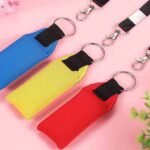When it comes to building products—whether it’s bags, laptop sleeves, wetsuits, or protective gear—the material is never just a background choice. It defines the feel, function, cost, and even brand value. Among the countless textiles and polymers available today, nylon and neoprene are two of the most debated. Nylon is known for its lightweight durability, while neoprene stands out for its cushioning, insulation, and premium look. But which one should you choose?
Nylon is a synthetic fabric prized for strength, abrasion resistance, and affordability, while neoprene is a synthetic rubber valued for insulation, shock absorption, and water resistance. Nylon suits bags, straps, and apparel where lightness and durability matter, whereas neoprene excels in wetsuits, protective sleeves, and products needing padding and waterproofing. The choice depends on application, cost, and user experience.
Imagine you’re a brand designing a new laptop sleeve. Nylon will make it slim, lightweight, and affordable. Neoprene will make it cushioned, sleek, and premium—but heavier and pricier. Or think of a sports bag: nylon handles abrasion on the outside, while neoprene lining protects gear inside. This guide will unpack the differences, so you don’t just pick a material—you pick the right partner for your product’s success.
What Are Nylon and Neoprene, and How Are They Made?
Nylon is a family of synthetic polyamide fibers, woven or knitted into fabrics, often reinforced with denier ratings (210D, 600D, 1680D). Neoprene is a synthetic rubber (polychloroprene), produced in foamed sheets or solid form, offering insulation and cushioning. Nylon is textile-based, while neoprene is rubber-based. Their different origins explain why nylon excels in tensile strength and abrasion, while neoprene is better for shock absorption and water resistance.
1. Nylon: The First Synthetic Fiber

- Invention: Nylon was introduced by DuPont in 1935 and quickly revolutionized textiles.
- Chemistry: Produced by combining adipic acid with hexamethylenediamine → polyamide chains.
- Process:
- Polymer chips melted and extruded through spinnerets.
- Filaments stretched, oriented, and cooled.
- Twisted into yarns.
- Woven, knitted, or bonded into fabrics.
- Grades:
- Nylon 6/6: Strong, abrasion-resistant.
- Nylon 6: Slightly softer, good dye uptake.
- Nylon 12: Flexible, chemical-resistant.
- Commercial Forms: Ripstop nylon, ballistic nylon, Cordura® — widely used in backpacks, webbing, and outdoor gear.
2. Neoprene: Synthetic Rubber for Protection

- Invention: Neoprene was developed in 1930, also by DuPont, as an oil-resistant substitute for natural rubber.
- Chemistry: Chloroprene monomers polymerized into polychloroprene rubber.
- Process:
- Produced as sheets of solid rubber.
- Expanded into foam (closed-cell structure) to trap insulating air.
- Laminated with fabrics (often nylon or polyester) for durability.
- Forms:
- Solid neoprene sheets (industrial gaskets).
- Foamed neoprene (wetsuits, braces, covers).
- Laminated composites (neoprene + nylon for bags/sleeves).
3. Why They Differ So Much
- Nylon = fiber/fabric, made from filaments.
- Neoprene = rubber/foam, made from sheets.
- Nylon’s strength is in tensile performance; neoprene’s strength is in elasticity and shock absorption.
Comparison Table: Nylon vs Neoprene Origins
| Feature | Nylon | Neoprene |
|---|---|---|
| Type | Synthetic polyamide fiber (plastic) | Synthetic rubber (polychloroprene) |
| Year Invented | 1935 (DuPont) | 1930 (DuPont) |
| Form | Filaments → yarns → fabrics | Sheets → foam or solid rubber |
| Main Production Step | Polymer extrusion & spinning | Polymerization & foaming/lamination |
| Key Properties | High strength, abrasion resistance | Cushioning, insulation, waterproof |
| Common Uses | Bags, straps, apparel, outdoor gear | Wetsuits, covers, sleeves, braces |
In summary: Nylon is born from the world of textiles, engineered for lightness and strength. Neoprene comes from the world of rubber, engineered for protection, padding, and insulation. Both materials are synthetic and versatile, but their origins explain why they are often used together in hybrid products (nylon outer for durability + neoprene core for cushioning).
Which Mechanical Properties Matter Most—Strength, Stretch, and Abrasion?

Nylon excels in tensile strength and abrasion resistance, making it ideal for bags, straps, and outdoor gear. Neoprene offers superior stretch and compression recovery, giving it an edge in applications needing flexibility, cushioning, or insulation, such as wetsuits and protective sleeves. Nylon resists tearing under heavy loads, while neoprene sacrifices strength for elasticity. The choice depends on whether durability or flexibility is the higher priority for the end product.
Breaking Down Mechanical Properties
When deciding between nylon and neoprene, mechanical behavior under stress is one of the most critical considerations. Let’s look at the three key factors.
1. Strength (Tensile and Tear Resistance)
Nylon:
- Known for exceptional tensile strength — it resists being pulled apart under heavy loads.
- Common denier ratings (210D, 600D, 1680D) correlate to thickness and strength.
- Widely used in parachutes, climbing ropes, luggage webbing — all high-load applications.
Neoprene:
- Provides moderate tensile strength.
- Can tear more easily if used without fabric lamination.
- Not suitable for heavy load-bearing on its own, but often reinforced with nylon or polyester.
2. Stretch (Elasticity and Flexibility)
Nylon:
- Minimal stretch (3–10% under stress).
- Maintains structure — great for items where stability matters (straps, outer shells).
Neoprene:
- Extremely elastic, stretches up to 200% of its length without tearing.
- Recovers shape well after compression (low compression set).
- Ideal for form-fitting gear (wetsuits, braces, shock-absorbing sleeves).
3. Abrasion Resistance
Nylon:
- Among the best synthetic fibers for abrasion resistance.
- Can withstand repeated rubbing against rough surfaces.
- Preferred for backpacks, outdoor gear, and military-grade fabrics.
Neoprene:
- Poor abrasion resistance by itself — outer surfaces scuff quickly.
- To improve, it is often laminated with nylon or polyester fabric on one or both sides.
- Without lamination, neoprene products wear down under friction.
Comparison Table: Nylon vs Neoprene Mechanical Properties
| Property | Nylon (Textile) | Neoprene (Rubber/Foam) |
|---|---|---|
| Tensile Strength | Very High (load-bearing) | Medium (not for heavy loads) |
| Tear Resistance | High | Moderate |
| Stretch/Elasticity | Low (stable, rigid) | Very High (up to 200%) |
| Compression Recovery | Low | Excellent (cushioning) |
| Abrasion Resistance | Very High (durable) | Low (needs lamination) |
| Weight-to-Strength | Excellent (light + strong) | Poor (heavier per strength) |
Critical Insights
- If you need durability under stress (bags, straps, harnesses, luggage) → Nylon wins.
- If you need elasticity and cushioning (wetsuits, sleeves, padding) → Neoprene wins.
- Many products combine both: neoprene core for cushioning + nylon outer for abrasion resistance.
- Cost-effectiveness: Nylon offers stronger performance per gram; neoprene offers better performance per mm thickness.
In summary: Nylon and neoprene excel in very different mechanical domains. Nylon is about strength and durability, neoprene is about flexibility and comfort. The smartest designs often layer them together for a balance of protection and endurance.
How Do Thermal, Waterproof, and Weather-Resistance Compare?

Neoprene is naturally waterproof, insulating, and resistant to cold, making it ideal for wetsuits, covers, and protective gear. Nylon, by contrast, is not waterproof on its own but can be treated with coatings like PU, TPU, or DWR to repel water. Nylon excels in lightweight breathability but degrades faster under UV unless treated. Neoprene withstands saltwater and weather better but is heavier. The choice depends on whether water protection or lightweight versatility is the higher priority.
Comparing Environmental Performance
When it comes to resisting the elements, nylon and neoprene behave very differently because of their structural makeup:
- Nylon = textile fiber (hydrophilic) → absorbs water without treatments.
- Neoprene = closed-cell synthetic rubber (hydrophobic) → naturally resists water, retains heat.
1. Thermal Properties (Heat and Cold Insulation)
Nylon
- Thin and breathable; offers almost no insulation.
- Used in lightweight outdoor jackets where layering is more important than warmth.
- Susceptible to melting at high heat (~220°C), not suitable for high-temperature exposure.
Neoprene
- Excellent insulator due to trapped air in foam cells.
- Provides thermal protection in cold water, keeping divers warm.
- Resists heat better than nylon in terms of insulation but can stiffen over long exposures.
2. Waterproofing and Moisture Management
Nylon
- Absorbs moisture if untreated.
- Relies on coatings:
- PU (polyurethane): Cheap, moderate waterproofing.
- TPU (thermoplastic polyurethane): Stronger, flexible, long-lasting.
- DWR (durable water repellent): Causes water to bead up but wears off over time.
- Advantage: Lightweight and quick-drying once treated.
Neoprene
- Naturally waterproof (synthetic rubber).
- Closed-cell foam traps air → resists water penetration.
- Commonly laminated with nylon/polyester for surface durability, not water resistance.
3. UV, Saltwater, and Weather Resistance
Nylon
- Prone to UV degradation → fades and weakens if not UV-stabilized.
- Performs poorly in prolonged saltwater exposure.
- Requires coatings or blends for outdoor longevity.
Neoprene
- Naturally resistant to UV, ozone, and saltwater.
- Preferred for marine, outdoor, and sports applications.
- Over many years, can crack due to ozone exposure, but still outlasts untreated nylon.
Comparison Table: Thermal & Weather Performance
| Property | Nylon Fabric | Neoprene Foam/Rubber |
|---|---|---|
| Thermal Insulation | Very Low (breathable) | High (traps air, insulates) |
| Waterproofing | Requires coating (PU/TPU/DWR) | Naturally waterproof |
| UV Resistance | Low (degrades without UV stabilizers) | High (resists UV/ozone) |
| Saltwater Resistance | Low | High |
| Weight | Light | Heavy |
| Best Uses | Jackets, tents, lightweight gear | Wetsuits, sleeves, marine gear |
Critical Insights
- Waterproofing Strategy – Nylon needs chemical treatment; neoprene is inherently waterproof.
- Thermal Balance – Nylon = breathable/light, Neoprene = insulating/heavy.
- Outdoor Longevity – Neoprene resists UV and saltwater; nylon needs coatings and regular replacement.
- Hybrid Products – Many brands combine nylon exteriors for abrasion resistance with neoprene cores for insulation and waterproofing (e.g., camera cases, cooler bags).
In summary:
- If you want lightweight, breathable gear → Nylon (with coatings).
- If you need insulation, waterproofing, and all-weather toughness → Neoprene.
- Many innovative products combine the two for maximum performance.
Which Material Works Better for Specific Products and Industries?
Nylon dominates in bags, straps, luggage, apparel, and outdoor gear due to strength and low cost. Neoprene leads in wetsuits, laptop sleeves, koozies, medical braces, and protective covers where cushioning, elasticity, and insulation matter. Many hybrid products combine nylon exteriors with neoprene cores, balancing durability and comfort.
- Nylon Best For: backpacks, luggage, straps, parachutes, outdoor jackets.
- Neoprene Best For: wetsuits, sports supports, laptop/tablet sleeves, cooler bags.
- Hybrids: neoprene interior + nylon shell = durability + cushioning (e.g., camera cases).
Table: Product Applications
| Industry | Nylon Use | Neoprene Use |
|---|---|---|
| Bags/Luggage | Exteriors, straps | Protective sleeves |
| Apparel | Jackets, sportswear | Wetsuits, gloves |
| Outdoor Gear | Tents, ropes | Knee/elbow supports |
| Electronics | Laptop backpacks | Laptop sleeves, covers |
Do Comfort, Weight, and User Experience Differ in Real Use?

Neoprene is softer, cushioned, and insulating but heavier. Nylon is lighter, breathable, and more flexible in design. For long wear (jackets, backpacks), nylon provides better airflow, while neoprene adds comfort where padding or shock absorption is needed. The trade-off is weight vs. protection.
- Comfort: Neoprene cushions, conforms to body. Nylon can feel rougher but breathes better.
- Weight: Nylon’s strength-to-weight ratio is excellent. Neoprene adds noticeable bulk.
- User Experience: A neoprene laptop sleeve feels protective; a nylon one feels portable.
How Do Cost, Sustainability, and Compliance Compare?
Nylon is generally cheaper and more stable in pricing, while neoprene is more costly due to complex production. Nylon has established recycled options (rPET, rPA), making it more eco-friendly. Neoprene is petroleum-based but newer eco versions (limestone, plant-based) are emerging. Certifications like OEKO-TEX, REACH, and RoHS apply to both, ensuring safety in apparel and consumer goods.
- Cost: Nylon ~20–40% cheaper per yard than neoprene.
- Sustainability:
- Nylon: recycled nylon (ECONYL, rPET).
- Neoprene: limestone neoprene, Yulex (natural rubber alternative).
- Compliance: Both must pass EU REACH, OEKO-TEX for apparel.
How Do You Choose Between Nylon and Neoprene for Your Project?
Choose nylon when you need strength, abrasion resistance, lightweight design, and cost efficiency—ideal for bags, straps, and outdoor gear. Choose neoprene when you need cushioning, insulation, flexibility, or waterproofing—perfect for laptop sleeves, wetsuits, and protective covers. Many products use hybrids, with nylon exteriors for durability and neoprene cores for padding. The best choice depends on your product’s function, user experience, and price point.
When designing or sourcing a product, material choice is not just technical—it’s strategic. Nylon and neoprene offer very different performance profiles, and the right decision depends on what your customers expect, how your product will be used, and how much you want to spend.
1. Define the Product’s Primary Function
- Durability & Load-Bearing: If your product will face abrasion, heavy loads, or constant outdoor use (e.g., backpacks, straps, luggage), nylon is the safer choice.
- Protection & Cushioning: If your product needs shock absorption or insulation (e.g., laptop sleeves, camera cases, wetsuits), neoprene is unmatched.
2. Consider Comfort and End-User Experience
- Nylon: Lighter, breathable, easier to handle. Great for gear worn long hours.
- Neoprene: Thicker, cushioned, and insulating, but heavier. Feels premium for sleeves, supports, and sports gear.
3. Factor in Cost and Scalability
- Nylon is generally 20–40% cheaper per yard compared to neoprene.
- Neoprene’s higher cost is justified in premium products where comfort and protection are selling points.
- For large-scale, price-sensitive projects → nylon.
- For branded, premium or niche products → neoprene.
4. Environmental and Compliance Concerns
- Nylon: Available in recycled forms (rPET, ECONYL), popular for eco-conscious brands.
- Neoprene: Petroleum-based, but new eco versions (limestone neoprene, Yulex®) appeal to sustainability-focused markets.
5. Explore Hybrid Solutions
Many successful OEM products combine both:
- Example 1: Laptop backpack → nylon outer shell (durable) + neoprene padded compartment (protective).
- Example 2: Camera bag → nylon straps + neoprene-lined inserts.
- Example 3: Sports bag → nylon body + neoprene handle grip.
Hybrids deliver a balance of durability and comfort, and Szoneier already produces these for global brands.
Decision Matrix: Nylon vs Neoprene
| Product Type | Best Material Choice | Why It Works |
|---|---|---|
| Backpacks & Luggage | Nylon | Light, abrasion-resistant, cost-efficient |
| Laptop Sleeves | Neoprene (often with nylon shell) | Cushioned, waterproof, protective fit |
| Straps & Webbing | Nylon | Strong load-bearing, won’t deform |
| Wetsuits / Sports Gear | Neoprene | Stretch, insulation, waterproof |
| Medical Supports | Neoprene (laminated with nylon) | Compression, warmth, flexibility |
| Fashion Bags | Neoprene for premium look | Sleek aesthetic, soft hand feel |
| Outdoor Gear | Nylon | Weather-resistant (with coatings), lightweight |
| Industrial Covers | Neoprene | Oil, chemical, and weather resistance |
Conclusion: Why Source Nylon and Neoprene Products from Szoneier?
Choosing between nylon and neoprene isn’t just technical—it’s strategic. Nylon offers unbeatable strength and affordability, while neoprene delivers cushioning, water resistance, and premium performance. Many winning products combine both.
At Szoneier, with 18+ years of expertise in neoprene R&D and manufacturing, we produce:
- Neoprene bags, koozies, gloves, covers, wetsuits
- Nylon, polyester, cotton, and PP webbing straps
- OEM/ODM services with custom logos, designs, and packaging
- Low MOQ, fast sampling, and free design support
Ready to create your next nylon or neoprene product line?
Contact Szoneier today!
Szoneier—your trusted partner for custom nylon & neoprene solutions.











